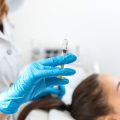Introduction to Chemical Peels and Non-Surgical Treatments in the UK
Across the UK, chemical peels and non-surgical aesthetic treatments have become a mainstay for those seeking refreshed, youthful skin without the need for invasive procedures. Chemical peels, which involve applying a solution to exfoliate and rejuvenate the skin, are celebrated for their ability to address concerns such as fine lines, pigmentation, and uneven texture. Alongside peels, British clients frequently opt for non-surgical treatments like dermal fillers, anti-wrinkle injections (such as Botox), microneedling, and advanced facials—each designed to subtly enhance natural beauty with minimal downtime. The trend of combining these treatments is steadily gaining momentum within clinics from London to Edinburgh. Why? Because integrating chemical peels with other non-invasive options can amplify results, offering a more holistic approach to skin health and aesthetic confidence. By tailoring combinations suited to individual needs, practitioners are helping clients achieve radiant, smoother complexions while ensuring each treatment feels both bespoke and effective—a true reflection of modern British beauty culture’s emphasis on subtlety and self-assurance.
Benefits of Combining Chemical Peels with Other Treatments
In the UK, combining chemical peels with other non-surgical treatments is becoming increasingly popular, and for good reason. The synergy between different therapies can deliver remarkable results that surpass the benefits of each treatment alone. By integrating chemical peels with procedures such as microneedling, dermal fillers, or LED light therapy, patients often experience enhanced skin rejuvenation, improved texture, and a more radiant, natural-looking complexion.
Synergistic Effects Explained
When chemical peels are paired with other non-invasive treatments, the skin’s natural healing and renewal processes are stimulated on multiple levels. For example, a chemical peel gently exfoliates the skin’s surface, allowing for better penetration and effectiveness of subsequent treatments like serums or fillers. This layered approach not only amplifies the benefits but also accelerates visible results.
Key Combined Benefits
| Treatment Combination | Main Benefits |
|---|---|
| Chemical Peel + Microneedling | Deeper collagen stimulation, smoother texture, and reduced fine lines |
| Chemical Peel + Dermal Fillers | Even skin tone, enhanced volume, and natural contours |
| Chemical Peel + LED Light Therapy | Reduced redness, improved healing, and brighter complexion |
Natural-Looking Results for UK Preferences
British clients often seek subtle yet noticeable improvements—aiming for a refreshed appearance rather than dramatic changes. Combining chemical peels with complementary treatments supports this goal, as the results tend to look more balanced and harmonious with one’s natural features. Ultimately, this holistic approach not only boosts confidence but also aligns beautifully with the understated elegance favoured across the UK.

3. Popular Complementary Treatments in the UK
In the United Kingdom, combining chemical peels with other non-surgical treatments is an approach embraced by many seeking a refreshed and confident appearance. Among the most popular complementary options are dermal fillers, anti-wrinkle injections, microdermabrasion, and LED therapy. Each of these treatments brings its unique benefits, and when thoughtfully paired with chemical peels, they can deliver remarkable, natural-looking results.
Dermal Fillers: Restoring Volume and Contour
Dermal fillers, a firm favourite among Britons, are used to restore lost volume, enhance facial contours, and smooth out deeper lines—especially in areas where peels may not fully address volume loss. When combined with a chemical peel, fillers can help sculpt the face after the skin’s texture and clarity have been improved, resulting in a harmonious, revitalised look that boosts self-assurance.
Anti-Wrinkle Injections: Smoothing Dynamic Lines
Anti-wrinkle injections (commonly known as Botox in the UK) target dynamic wrinkles caused by repeated facial movements. While chemical peels effectively treat surface-level skin concerns, combining them with anti-wrinkle injections tackles both texture and deeper expression lines. This synergy means clients can enjoy a smoother, more youthful complexion while maintaining natural facial expressions.
Microdermabrasion: Boosting Radiance
Microdermabrasion remains a beloved choice for those desiring instant radiance. As a gentle exfoliating procedure, it can be performed before a chemical peel to remove superficial dead skin cells, allowing the peel’s active ingredients to penetrate more effectively. This combination can enhance both the immediate glow and the long-term results of your skincare journey.
LED Therapy: Supporting Skin Recovery
LED therapy is increasingly popular across the UK for its calming and reparative properties. Utilising different wavelengths of light, this non-invasive treatment soothes post-peel skin, reduces redness, and accelerates healing. When integrated into a treatment plan, LED therapy not only supports recovery but also amplifies the rejuvenating effects of chemical peels, helping clients achieve their skin goals with greater comfort and confidence.
By thoughtfully combining these well-loved treatments, practitioners across the UK provide tailored solutions that address a range of skin concerns, empowering individuals to look and feel their very best—without surgery or downtime.
4. Treatment Suitability and Customisation
When considering the combination of chemical peels with other non-surgical treatments in the UK, one of the most important aspects is assessing patient suitability and tailoring treatment plans to the individual. The British approach to aesthetics strongly values personalisation, safety, and transparency, reflecting both clinical best practice and cultural preferences for natural-looking results.
Assessing Patient Suitability
A thorough consultation is crucial before any combined treatment. Practitioners in the UK typically evaluate:
| Assessment Factor | Considerations |
|---|---|
| Skin Type & Condition | Different Fitzpatrick skin types require tailored peel strengths and adjunct therapies to minimise risks of pigmentation or irritation. |
| Lifestyle Factors | Work schedule, sun exposure, and ability to commit to aftercare influence treatment selection and timing. |
| Medical History | History of allergies, medications (e.g., Roaccutane), or previous cosmetic procedures must be considered to prevent adverse reactions. |
| Desired Results | The patients aesthetic goals—whether subtle rejuvenation or a more dramatic transformation—guide treatment combinations and intensity. |
Customising Treatment Plans in the UK Context
UK practitioners are known for their cautious and conservative approach, favouring gradual enhancement over drastic change. Customisation is not just about choosing products but also sequencing treatments for optimal safety and effect. For instance, scheduling chemical peels a few weeks before or after injectables like Botox or dermal fillers allows the skin time to heal, reducing complication risks. Similarly, pairing gentle peels with hydrating facials suits those who prefer minimal downtime—a popular preference among British clients leading busy lifestyles.
Example of Personalised Combination Plans
| Skin Type/Concern | Suggested Combination | Rationale |
|---|---|---|
| Sensitive Skin | Mild chemical peel + LED light therapy | Minimal irritation while promoting collagen production and soothing inflammation. |
| Pigmentation Issues | Medium-depth peel + microneedling (staggered appointments) | Addresses uneven tone while stimulating deeper skin renewal without overwhelming the skin barrier. |
| Aging Concerns | Chemical peel + anti-wrinkle injections (Botox) | Smooths texture and fine lines; scheduled separately for best results and safety. |
Your Safety Comes First: UK Standards Matter
The UKs regulatory environment places strong emphasis on practitioner qualifications and evidence-based protocols. Always ensure your chosen clinic is registered with reputable bodies such as the Care Quality Commission (CQC) or Save Face. By choosing custom-tailored treatments from qualified professionals, you can achieve radiant, authentic results that fit perfectly with your lifestyle—and feel confident every step of the way.
5. Aftercare and Recovery Considerations
When combining chemical peels with other non-surgical treatments popular in the UK, such as microneedling, dermal fillers, or laser therapies, aftercare becomes especially important for achieving the best results and ensuring a smooth recovery. British weather—often unpredictable with frequent rain, cool winds, and occasional bursts of sun—means that your post-treatment routine should be tailored to protect your skin from local environmental factors.
Best Practices for Post-Treatment Care
After any skin treatment, but particularly when layering procedures, gentle care is crucial. Avoiding harsh cleansers and exfoliants is a must; instead, opt for fragrance-free, soothing products that help maintain your skin’s natural barrier. Hydration is key—both inside and out—so drink plenty of water and use a good quality moisturiser suitable for your skin type. Since British homes often have central heating, which can dry out the air, consider using a humidifier during colder months to keep your skin comfortable and hydrated.
Sun Protection: A Year-Round Priority
Even though the UK isn’t famous for its sunshine, UV exposure can still affect sensitive, freshly treated skin. Always apply a broad-spectrum SPF 30 or higher, rain or shine. Lightweight, non-greasy formulations are widely available and blend easily into daily routines—no excuses! Remember, cloud cover does not block UV rays entirely, so don’t skip this essential step even on overcast days.
Culturally Relevant Tips for Maintaining Results
British lifestyles are active and social, but also often involve commuting in all weathers and spending time in bustling urban environments. After treatment, try to limit exposure to pollution and avoid crowded places like gyms or public transport for the first couple of days if possible, as this can help reduce the risk of irritation or infection. Many Britons enjoy outdoor activities like walking in the park or countryside; if you do venture out, wear a wide-brimmed hat and sunglasses for added protection.
Patience and Consistency: The British Way
Recovery is a gradual process, and patience pays off. Stick to your practitioner’s advice regarding when to resume your normal skincare routine or schedule further treatments. Avoid the temptation to rush things—results build over time. Embrace the British spirit of “keep calm and carry on,” knowing that with gentle care and mindful protection, your skin will look its best for months to come.
6. Seeking Advice from Qualified UK Practitioners
When considering combining chemical peels with other non-surgical treatments popular in the UK, it is absolutely essential to seek guidance from experienced and registered professionals. Your safety and satisfaction should always come first, and only a qualified practitioner can provide you with tailored advice that considers your unique skin type, concerns, and goals.
Before booking any treatment, take the time to research clinics and practitioners thoroughly. In the UK, reputable professionals are registered with bodies such as the General Medical Council (GMC), Nursing and Midwifery Council (NMC), or the British Association of Dermatologists (BAD). These accreditations are a strong indicator of proper training, ongoing professional development, and adherence to strict ethical standards.
Don’t hesitate to ask for proof of qualifications, insurance, and experience with the specific combination of treatments you’re interested in. A trustworthy clinic will be open about their credentials and happy to answer all your questions. Look for clinics that follow national safety guidelines set out by organisations like the Care Quality Commission (CQC) or Save Face accreditation, ensuring a high standard of care and hygiene.
Remember, the best results come from a personalised approach. An experienced practitioner will assess your medical history, listen to your concerns, and recommend a bespoke treatment plan designed specifically for you. This not only enhances your results but also minimises risks and side effects.
Choosing the right professional is an act of self-respect and self-care. By investing time in finding a trustworthy clinic and registered practitioner, you are taking a confident step towards achieving your aesthetic goals safely and effectively—just as many people across the UK do every day.


